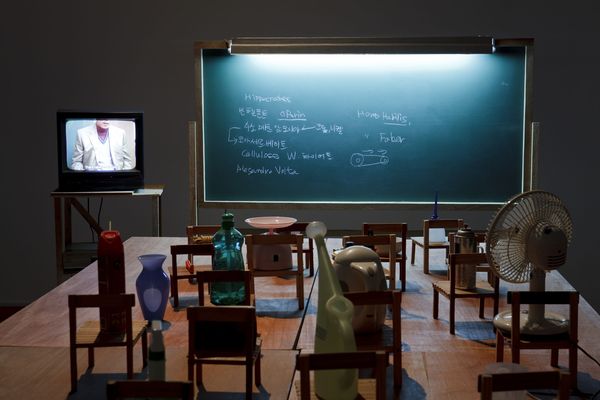
Kim Beom likes to turn things upside down. In his latest exhibition at REDCAT, titled “Animalia,” the Korean artist upends the natural order, questioning whether it is in fact so natural. Sheathing a preoccupation with power dynamics in a wry sense of humor and a penchant for the absurd, his installations, drawings and videos question the distinctions we routinely make between ourselves, animals and objects.
This tactic of inversion is most obvious in the video “Spectacle,” in which a popular scene from nature documentaries — a cheetah chasing an antelope — is doctored so that the antelope is chasing the cheetah. It’s a simple reversal of what television has framed and reinforced as “natural.” Of course, Kim isn’t suggesting that antelopes could or should chase cheetahs; rather, by altering the video, he raises a question: Why, of all the natural dramas captured on camera, is this the one that resonates?
Perhaps it’s because we’re bloodthirsty exploiters. In the installation “Objects Being Taught They Are Nothing But Tools,” Kim takes education to task as an instrument of social control. The piece is essentially a schoolroom for small consumer goods in which a fan, a teakettle, a bottle of dish soap, and other sundries sit on little wooden chairs in front of a chalkboard. The instructor appears on a small television, his head cut off at the top edge of the screen. He talks about the history of human rights, and the workings of capitalism and consumerism but this lecture is intended not to inspire, but rather to tamp down aspiration. The objects are told that no matter how much people become attached to them, they have no “essential value” outside of their economic use. The idea of teaching consumer products not to rise up and seize their destinies is comical, but the familiar educational format makes it easy to imagine children or employees sitting in the seats instead. In treating objects like people, Kim reveals the hard logic under which people are often seen as tools.

This installation is given context by a selection of fantastic drawings and blueprints of imaginary prisons, a lighthouse, an immigration office and a school. Kim envisions these structures as diagrams of power: prisoners fuel the lighthouse by riding bicycles in its base; one incarceration center involves housing “heinous criminals” in a maze-like structure with “offensive beasts.” Despite their punitive uses, these buildings are invariably wrapped in serene, cloud-like white forms — they could be Apple products.
The drawings are indictments of bureaucracy and cruelty, but they are also fanciful imaginings, not unlike the complex maps that children draw of invented worlds. One design — for a tyrant’s safe house — looks suspiciously like an elongated version of Frank Lloyd Wright’s Guggenheim Museum. This lair, we learn from the blueprint, is guarded not just by dogs, but by “wolf-dog hybrids,” wolves, and finally, preposterously, by “wolf-men,” each indicated by a different symbol and deployed in a different place.
This fantasy of mastery is simultaneously the purview of the child and the megalomaniac, and the drawings poke fun at the notion of total control even as they gently indulge it. Here, the logic of Kim’s inversions becomes clear: Oppression and imagination are two sides of the same coin. Even as he lays bare the deadening effects of the product-driven society we have envisioned and built for ourselves, Kim reveals how imagination might enable us to see a bit of ourselves in everything, perhaps even in other people.
-- Sharon Mizota
The Gallery at REDCAT, 631 W. 2nd St., (213) 237-2800, through June 19. Closed Mondays. www.redcat.org
Photos, from top: Kim Beom, "Objects Being Taught They Are Nothing But Tools," 2010, installation view at REDCAT; "Animalia," 2011, installation view. Credit: Scott Groller